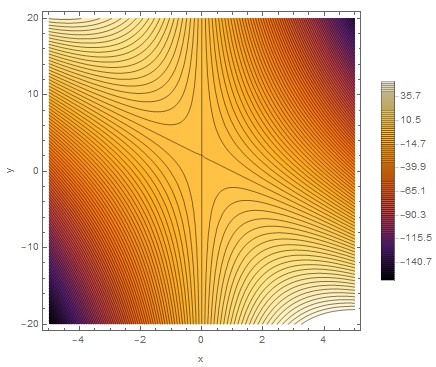What are the values and types of the critical points, if any, of f(x,y)=x(2−x−y)?
1 Answer
Saddle point at
Explanation:
I will assume by "critical points" you are referring to the values of
First we need to find the partial derivatives of the function:
The
by use of the chain rule.
The
We now take both of these equations, and set them equal to 0 to obtain a pair of simultaneous equations which can then be solved to obtain one or more pairs of co-ordinates where our stationary point lies, so:
Immediately we can obviously see
for the top equation. This has the solution:
So we have only one stationary point at
In order to classify the point we now need to find the higher order derivatives, those will be:
We can classify the points by:
then it will be a saddle point, or else if:
then it will be a maximum or minimum. Substituting the values of our derivative in we get:
I have included a contour plot of the function below (I did try a 3d plot at first but the shallowness of the gradient did not make the turning point clear enough). On the image the darker regions represent values of low
We see that going from the bottom left to the top right you go up "over a hill" reaching a maximum at the calculated stationary point. Similarly going from the top left to the bottom right you go through the "bottom of a valley" with the minimum being at the calculated stationary point.
In other words, we notice that the contours from all directions converge at


